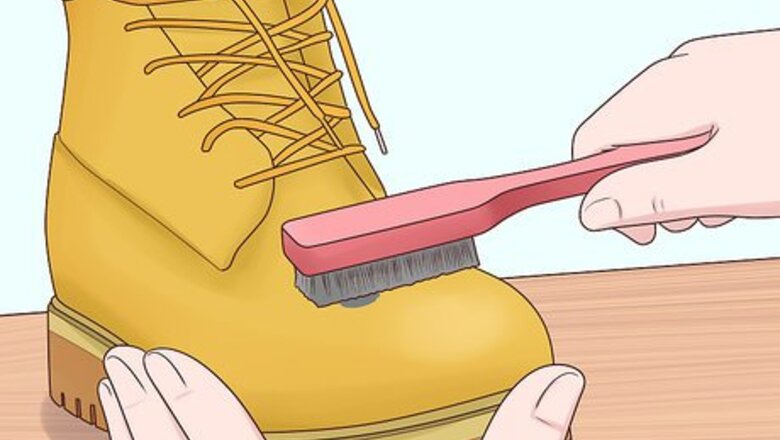
views
X
Research source
Cleaning Small Spots
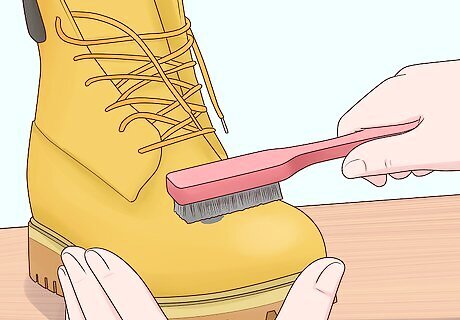
Remove small debris with a soft brush. Start any Timberland cleaning session by brushing off the boot. Start at the top of the ankle and brush back and forth all the way down the whole surface of the boot. If you just have a small amount of debris stuck to your boots, this light brushing will typically remove it. If there are deeper scuffs or lots of debris, you should use the brush to remove as much debris as possible before moving on to other cleaning methods. You can use any clean, soft brush for cleaning your Timberland boots. However, the Timberland company does sell a kit that is made specifically for cleaning Timberland boots. You can also get a brush that is specifically made for brushing suede or nubuck, which is usually called a "suede brush."
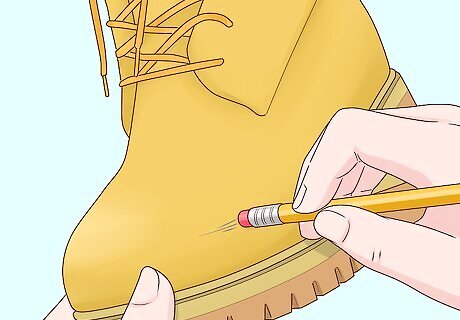
Remove scuff marks with an eraser. Use a simple pencil eraser, a generic suede eraser, or a Timberland cleaning bar to remove scuff marks on the surface of the boots. Rub the eraser or cleaning bar lightly over the marks until they disappear. The eraser or cleaning bar can take care of most day-to-day scuffs and light marks. They do not work well for removing ground-in dirt or mud that has covered your whole boot. Mr. Clean Magic Eraser or a similar brand can also help get out scuff marks. Get the marks a little wet before rubbing them with the eraser.
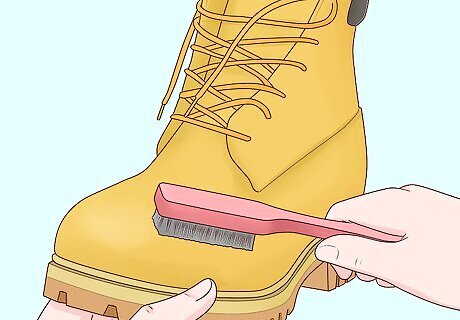
Brush the boot once again. Once you have erased all marks on the boot, use the brush to smooth out the surface of the nubuck. The brush will also remove any eraser debris that might remain. Move the brush lightly across the surface of the boot, making sure to move it in 1 direction. This will ensure that the surface has a uniform look when you are done cleaning it.
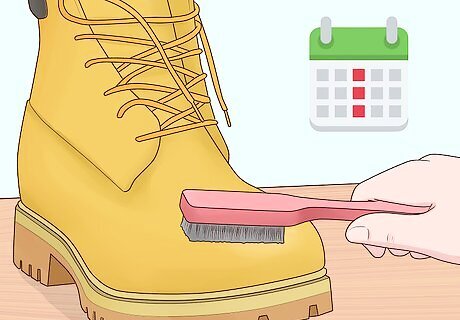
Do spot cleaning on a regular basis. Keep your Timberland boots clean by removing dirt once per week. This is especially important if they are worn on a daily basis, as dirt and grime can really build up. With some weekly maintenance you can keep your boots looking fresh and new for a long time.
Deep-Cleaning Your Boots

Purchase nubuck cleaning and sealing products that match your boots. The products you use should be designed for your boots’ specific fabric. Timberland boots come in suede and leather styles, but the traditional Timberland boot is make of nubuck. Suede and nubuck can typically be cleaned with the same cleaner. Make sure to buy leather cleaning supplies that match the color of your leather. Look on the packaging of a potential product and make sure that it can clean the yellow leather that a Timberland boot is usually made of. If you are unsure of what product to purchase, go to your local boot and shoe repair store and ask if they sell any products that would be appropriate.
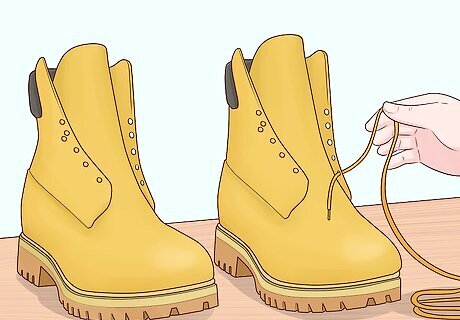
Remove the shoelaces. Take the shoelaces from each boot and set them aside if they are clean. If they are not clean, wash them by hand and let them dry completely before putting them back in your boots. Wash the laces in warm soapy water until all of the dirt has been removed. For a thorough cleaning job, scrub them together with the soap and then soak them in warm water. Once cleaned, hang them out to dry. You could also include them in a load of laundry in a washing machine. Keep in mind that if they are really dirty, you will probably want to wash them separately from your clothes.
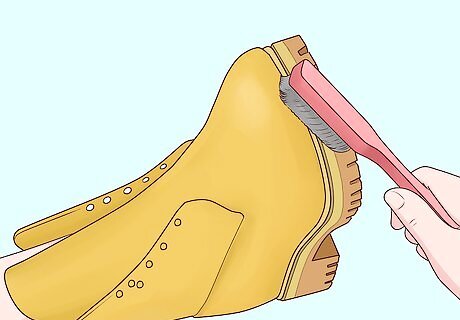
Remove loose dirt and debris with a soft-bristle brush. Brush off each boot with a brush to remove any dirt particles. Use a light touch, as you don't want to scratch the surface of your boots, but your soft-bristle brush should be safe for your boots. Removing as much dirt as possible at the beginning will minimize the amount of scrubbing you have to do later on. Don't forget the bottom of the Timberlands. The soles are especially likely to pick up loose dirt and gravel that can be brushed off easily before cleaning. If you don’t brush this dirt off, you’re likely to have a muddy mess on your hands and in your house. Brushes work better than towels simply because they can get into the nooks and crannies of the boots; however, be careful when using a brush on leather boots, as brushes with very hard bristles may scratch the leather.

Keep one hand inside the boot. While cleaning the boot, you need to focus on keeping its shape intact. Keeping one hand in the boot will apply opposite pressure against the area you are cleaning, keeping it from collapsing as you scrub it. You can also use your hand to push up on creases and wrinkles that you want to get rid of. If you push up on them while cleaning, the combination of your pressure and the moisture from the cleaner can reshape those areas.
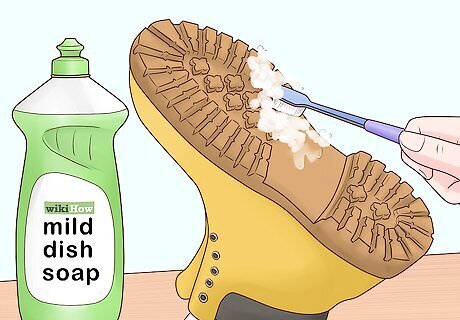
Scrub the soles with a toothbrush and mild dish soap. Rinse the rubber soles of the Timberland boots with water and scrub them with soap using a toothbrush. Gently scrape out any buildup that is in the soles. Rinse the soles with warm water to get out any remaining debris and inspect your work. You could also use cotton swabs to get the dirt out of the tread. Dip the cotton swab in warm, soapy water and run it along the grooves until all of the dirt has been removed.
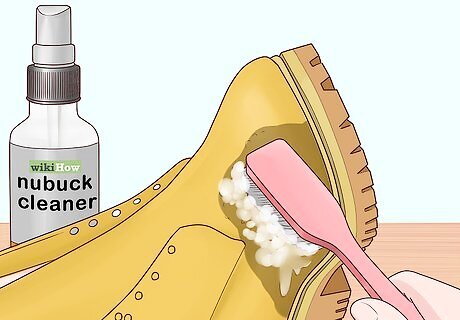
Scrub the outside of the boot with cleaner and water. Use your cleaner, warm water, and your soft brush to scrub the outside of the upper part of the boot. Move the brush in 1 direction to keep the surface of the boot in good shape. Also, try to use the minimum amount of pressure you need to get any dirt off the surface. Keep scrubbing, and apply more cleaner if necessary, until the surface is clean. Make sure to follow the directions on the cleaner to apply it and scrub out stains. You can also use a soft toothbrush to really clean deep into the seams of the boots.
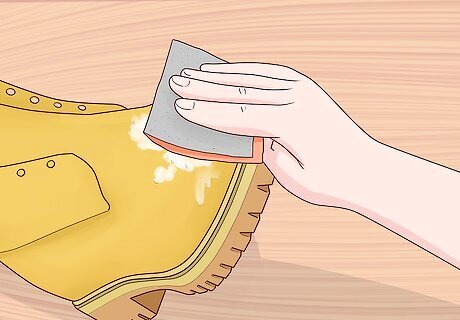
Use sandpaper to buff out remaining stains. If there are noticeable stains that have not been removed by cleaning the boots, you may be able to buff them out with a small piece of fine-grit sandpaper. Using a 400-grit sandpaper and a light touch, move the sandpaper in just 1 direction, and stop sanding as soon as the stain disappears. This is a delicate process that should be used as a last resort and you definitely don't want to sand too hard. However, this will get rid of some stubborn stains immediately.
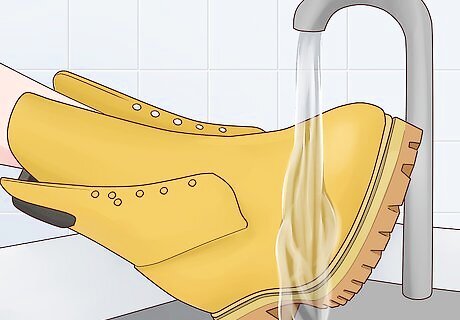
Rinse the surface with a small amount of water. Once you are satisfied that the dirt and grime has been scrubbed out, it's time to rinse the surface. Use a small amount of water to remove the cleaner residue and any remaining grime.

Do deep cleaning when necessary. How often you do deep cleaning depends on how often you wear your boots and how dirty they get when you wear them. Overall, you should focus on cleaning them when they look dirty and spot cleaning will not suffice anymore. If you wear your boots daily and they get very dirty, you may need to do deep cleaning on a weekly basis. If your boots stay relatively clean when you wear them, then you may only need to clean them every month or two. If you want to deodorize the interior of your boot, try spraying SteriShoe, Mycomist sanitizer, or Lysol antibacterial spray inside your shoe to kill any growing bacteria.
Drying and Buffing Your Boots

Support the shape of the boot with paper. If the boot appears misshapen after cleaning, you should reshape it before it dries. Typically, the toe of the boot is the part that gets most out of shape from cleaning. To fix it, crumple up paper and stuff it down into the boot to push misshapen areas into place. You can use newspaper, scrap paper, extra paper bags, or any other type of paper to shape your boot.
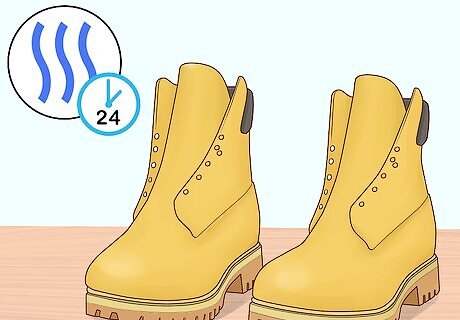
Let your boots air dry for 24 hours. Once the cleaning agent has been applied and any stains treated, let the boots air dry in warm air. They should take around 24 hours to dry completely, depending on how wet they got during cleaning. Do not place the boots near high heat, such as a fire. High heat could potentially melt any glue holding the boot together, or destroy the leather parts of your boots.
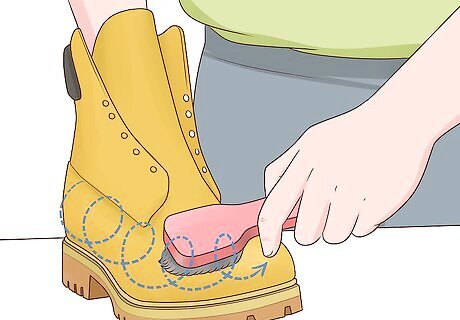
Buff your boots. Once the boots are dry, they may still look a little funny. This is because the surface of the nubuck is likely matted and needs some care. Use a clean, dry brush to lightly brush the surface of the boot in 1 direction. This will make the boots look like normal again. If the boot is really matted, so much so that brushing it doesn’t do much, hold the boot close to the steam from a kettle and then scrub it with a toothbrush. The steam should untangle the matted nap, allowing you to scrub it straight and make it stand up again.
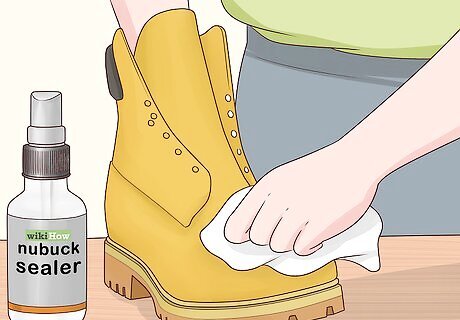
Condition or seal your boots. Pick a conditioner or sealer to protect the newly clean surface of your boots. Follow the directions on the packaging when applying it. In general, these products are applied by putting a small amount of them on a clean rag and wiping it over the entire surface of the boot. Conditioner is made just to keep the leather from drying out and will allow the leather to stretch a little so you can break the shoes in more easily.A water-proofing product is meant to help keep water from soaking into the leather. Both products can be great for your boots but they should not be used at the same time.




















Comments
0 comment